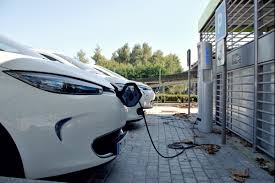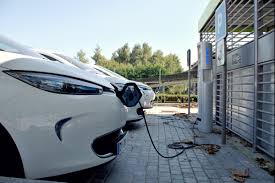
The Evolving Role of Power Electronics in Battery Electric Vehicles
As alternative fuels and vehicle technologies continue to advance, the components within these systems are also evolving. In battery electric vehicles (BEVs), power electronics play a crucial role in optimizing functionality and efficiency. Businesses adopting BEVs or preparing for the future of sustainable transportation must understand the significance of these components.
Previously, we explored the role of software in various vehicle technologies and the benefits it offers to original equipment manufacturers (OEMs). This article focuses on the importance of power electronics in BEVs.
Power Electronics and Their Function in BEVs
At the heart of a BEV is its high-capacity battery pack, which supplies energy to the electric motor. Unlike traditional internal combustion engines, BEVs efficiently convert electrical energy into mechanical power, resulting in smooth, quiet operation, rapid acceleration, and minimal emissions. With fewer moving parts than diesel-powered vehicles, BEV drivetrains are simpler, requiring less maintenance and reducing mechanical downtime.
Power electronics encompass components responsible for converting and managing electric power within BEVs, ensuring optimal performance and an enhanced driving experience. A key element is the electronic control module (ECM), which performs a similar function in both diesel and hydrogen fuel cell vehicles. Acting as the central command system, power electronics regulate electricity flow between the battery, motor, and other systems, transforming stored energy into the precise forms required for propulsion and auxiliary functions.
In BEVs, power electronics facilitate instant torque and responsive acceleration using inverters, converters, and controllers. These systems manage high voltage and current demands while protecting against power fluctuations, which is essential for battery longevity and vehicle safety.
Beyond enhancing functionality, power electronics contribute to emissions reduction by maximizing energy efficiency. Effective power management extends driving range, minimizes energy waste, and supports the transition to more sustainable transportation.
The Role of Power Electronics in Hybrid and BEVs
Power electronics are integral to both hybrid and BEVs, overseeing electrical flow to enhance performance and prolong battery life. These components convert the battery’s Direct Current (DC) into Alternating Current (AC) to power the motor and reverse the process during regenerative braking. This improves overall efficiency, balances power distribution, and prevents voltage surges that could damage the battery.
In commercial applications, such as electric buses and delivery trucks, power electronics provide substantial benefits. Heavy-duty electric trucks rely on precise torque control to navigate diverse terrains, while electric buses optimize power distribution between propulsion and auxiliary systems, such as climate control, to enhance passenger comfort.
Cummins Inc. is driving advancements in power electronics to improve energy efficiency and vehicle range. These innovations help commercial electric vehicles travel farther, charge more quickly, and utilize energy more effectively, making them a practical and cost-efficient choice for fleet operators. Such progress is essential for achieving cleaner and more sustainable commercial transportation.
Key Considerations for Power Electronics in BEVs
To fully leverage the advantages of power electronics in BEVs, continuous innovation and adaptability are necessary. As BEVs incorporate advanced driver-assistance systems (ADAS), power electronics must ensure both efficiency and real-time safety reliability.
Cost is another critical factor. Well-designed power electronics can reduce BEV development expenses by optimizing energy use and minimizing the need for expensive cooling solutions. This is especially important for commercial BEVs, where operational efficiency directly affects profitability.
With the industry shifting toward higher voltage systems to improve efficiency and performance, power electronics must effectively manage voltage levels to maintain safety. Cummins is addressing this transition by enhancing thermal management, electromagnetic compatibility, and component integration, making BEVs more practical while aligning with environmental sustainability goals.
As BEV technology continues to evolve, power electronics will remain essential in improving efficiency, reliability, and widespread adoption, ultimately driving the future of sustainable transportation.
Cummins is a leader in innovative transportation solutions, and its zero-emissions division, Accelera™ by Cummins, is spearheading the development and integration of clean energy technologies to decarbonize some of the world’s most demanding industries.
Click here to know more information about BEV and FCEVs.
As alternative fuels and vehicle technologies continue to advance, the components within these systems are also evolving. In battery electric vehicles (BEVs), power electronics play a crucial role in optimizing functionality and efficiency. Businesses adopting BEVs or preparing for the future of sustainable transportation must understand the significance of these components.
Previously, we explored the role of software in various vehicle technologies and the benefits it offers to original equipment manufacturers (OEMs). This article focuses on the importance of power electronics in BEVs.
Power Electronics and Their Function in BEVs
At the heart of a BEV is its high-capacity battery pack, which supplies energy to the electric motor. Unlike traditional internal combustion engines, BEVs efficiently convert electrical energy into mechanical power, resulting in smooth, quiet operation, rapid acceleration, and minimal emissions. With fewer moving parts than diesel-powered vehicles, BEV drivetrains are simpler, requiring less maintenance and reducing mechanical downtime.
Power electronics encompass components responsible for converting and managing electric power within BEVs, ensuring optimal performance and an enhanced driving experience. A key element is the electronic control module (ECM), which performs a similar function in both diesel and hydrogen fuel cell vehicles. Acting as the central command system, power electronics regulate electricity flow between the battery, motor, and other systems, transforming stored energy into the precise forms required for propulsion and auxiliary functions.
In BEVs, power electronics facilitate instant torque and responsive acceleration using inverters, converters, and controllers. These systems manage high voltage and current demands while protecting against power fluctuations, which is essential for battery longevity and vehicle safety.
Beyond enhancing functionality, power electronics contribute to emissions reduction by maximizing energy efficiency. Effective power management extends driving range, minimizes energy waste, and supports the transition to more sustainable transportation.
The Role of Power Electronics in Hybrid and BEVs
Power electronics are integral to both hybrid and BEVs, overseeing electrical flow to enhance performance and prolong battery life. These components convert the battery’s Direct Current (DC) into Alternating Current (AC) to power the motor and reverse the process during regenerative braking. This improves overall efficiency, balances power distribution, and prevents voltage surges that could damage the battery.
In commercial applications, such as electric buses and delivery trucks, power electronics provide substantial benefits. Heavy-duty electric trucks rely on precise torque control to navigate diverse terrains, while electric buses optimize power distribution between propulsion and auxiliary systems, such as climate control, to enhance passenger comfort.
Cummins Inc. is driving advancements in power electronics to improve energy efficiency and vehicle range. These innovations help commercial electric vehicles travel farther, charge more quickly, and utilize energy more effectively, making them a practical and cost-efficient choice for fleet operators. Such progress is essential for achieving cleaner and more sustainable commercial transportation.
Key Considerations for Power Electronics in BEVs
To fully leverage the advantages of power electronics in BEVs, continuous innovation and adaptability are necessary. As BEVs incorporate advanced driver-assistance systems (ADAS), power electronics must ensure both efficiency and real-time safety reliability.
Cost is another critical factor. Well-designed power electronics can reduce BEV development expenses by optimizing energy use and minimizing the need for expensive cooling solutions. This is especially important for commercial BEVs, where operational efficiency directly affects profitability.
With the industry shifting toward higher voltage systems to improve efficiency and performance, power electronics must effectively manage voltage levels to maintain safety. Cummins is addressing this transition by enhancing thermal management, electromagnetic compatibility, and component integration, making BEVs more practical while aligning with environmental sustainability goals.
As BEV technology continues to evolve, power electronics will remain essential in improving efficiency, reliability, and widespread adoption, ultimately driving the future of sustainable transportation.
Cummins is a leader in innovative transportation solutions, and its zero-emissions division, Accelera™ by Cummins, is spearheading the development and integration of clean energy technologies to decarbonize some of the world’s most demanding industries.
Click here to know more information about BEV and FCEVs.


 The Role of Power Electronics in BEVs: Efficiency, Performance & Sustainability
The Role of Power Electronics in BEVs: Efficiency, Performance & Sustainability




 Companies
Companies